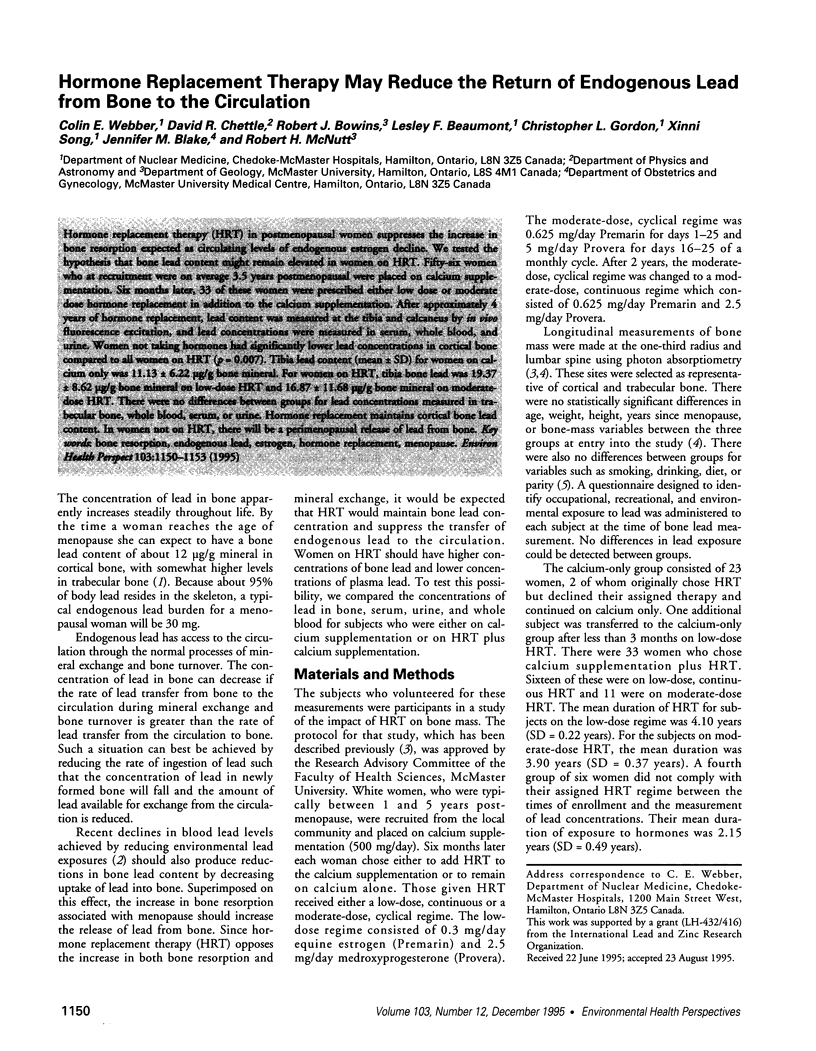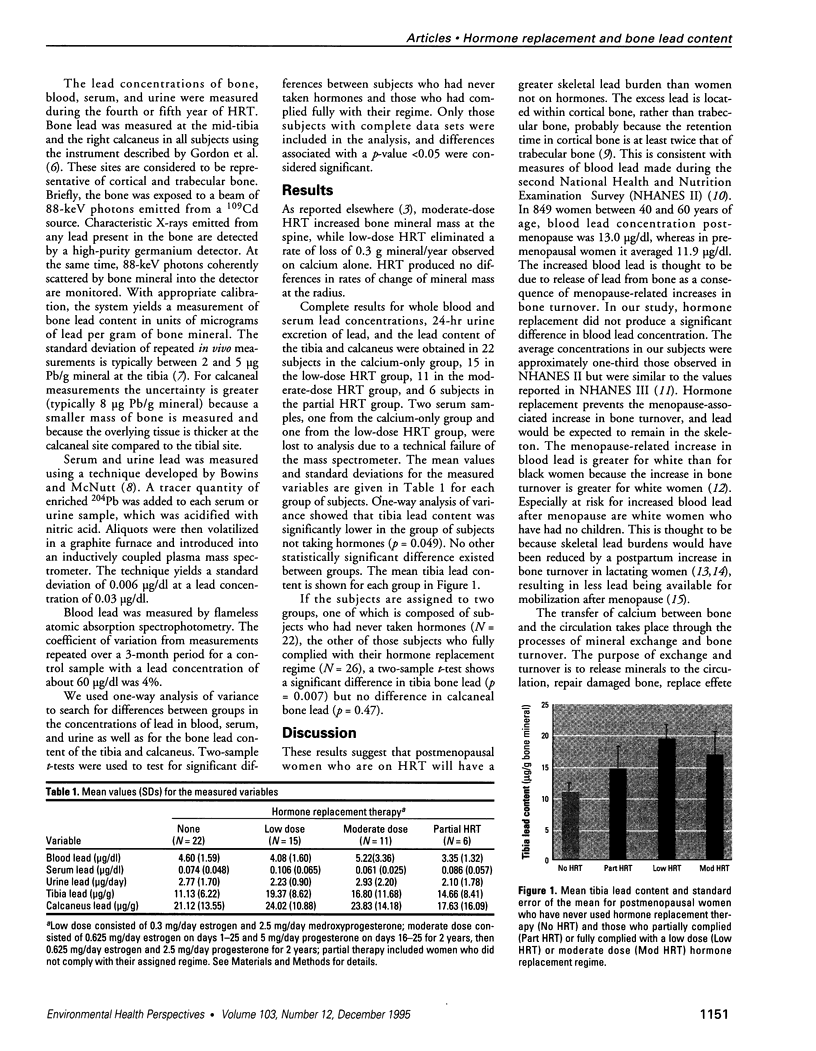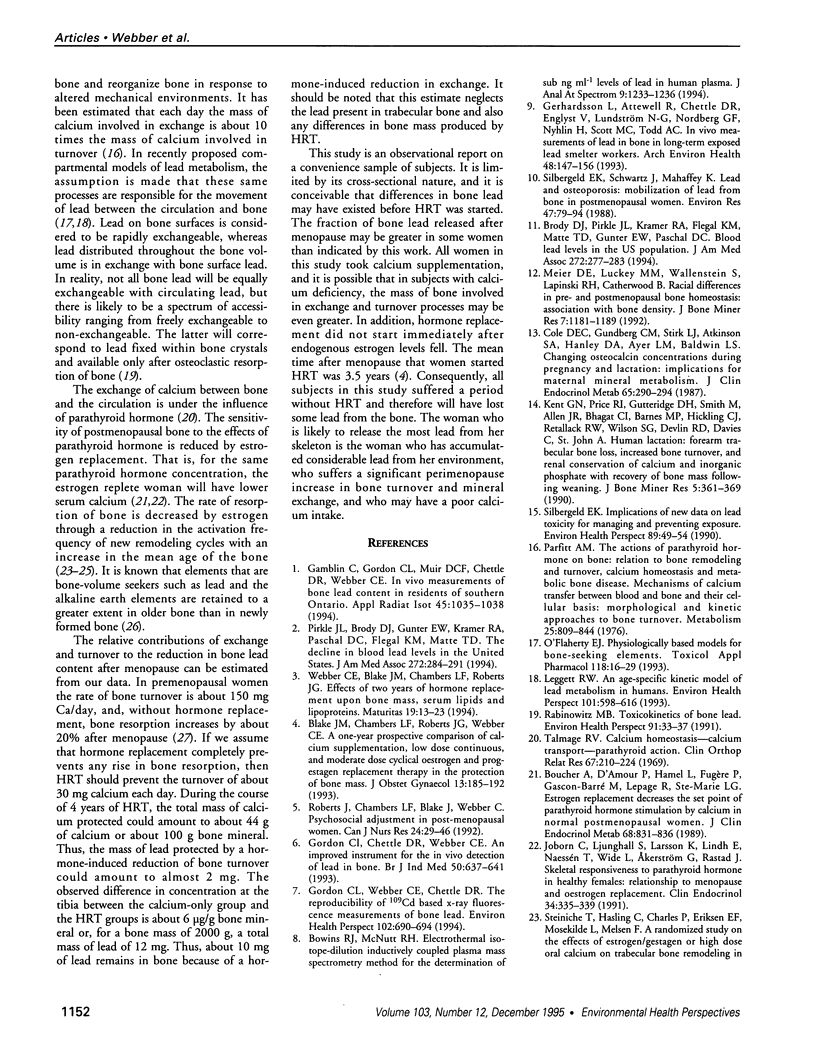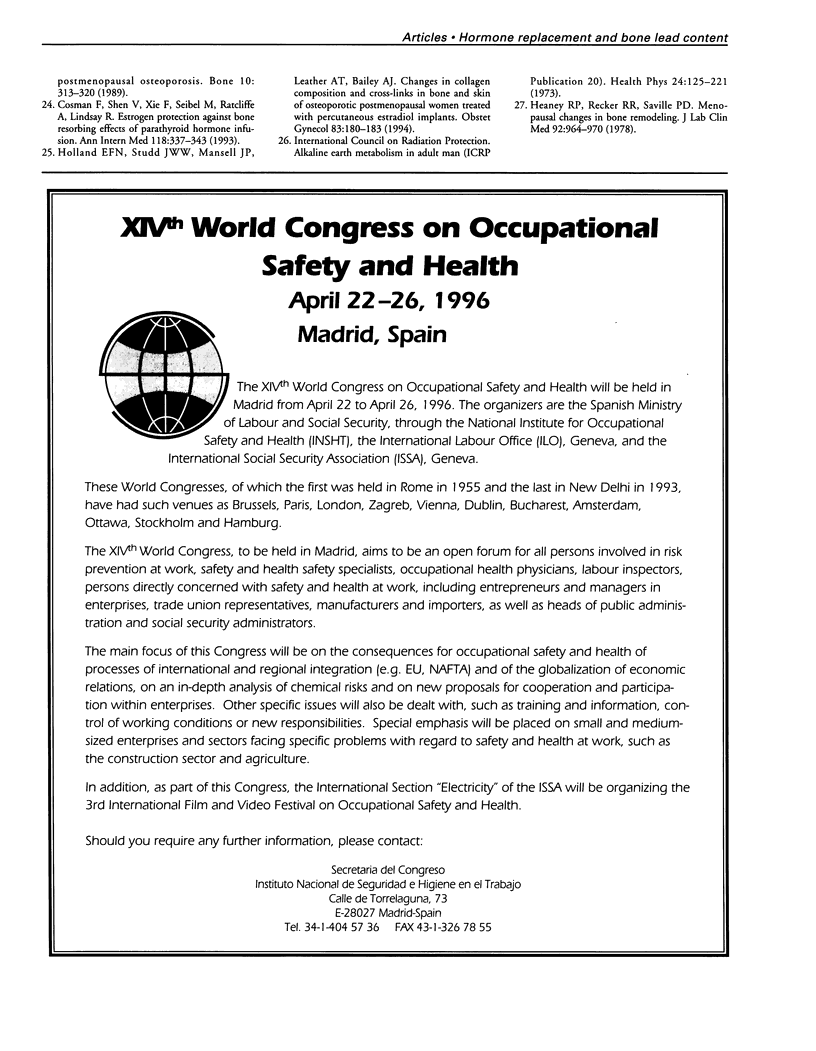Abstract
Hormone replacement therapy (HRT) in postmenopausal women suppresses the increase in bone resorption expected as circulating levels of endogenous estrogen decline. We tested the hypothesis that bone lead content might remain elevated in women on HRT. Fifty six women who at recruitment were on average 35 years postmenopausal were placed on calcium supplementation. Six months later 33 of these women were prescribed either low dose or moderate dose hormone replacement in addition to the calcium supplementation. After approximately 4 years of hormone replacement, lead content was measured at the tibia and calcaneus by in vivo fluorescence excitation, and lead concentrations were measured in serum, whole blood, and urine. Women not taking hormones had significantly lower lead concentrations in cortical bone compared to all women on HRT (p = 0.007). Tibia lead content (mean +/- SD) for women on calcium only was 11.13 +/- 6.22 microgram/g bone mineral. For women on HRT, tibia bone lead was 19.37 +/- 8.62 micrograms/g bone mineral on low-dose HRT and 16.87 +/- 11.68 micrograms/g bone mineral on moderate-dose HRT. There were no differences between groups for lead concentrations measured in trabecular bone, whole blood, serum or urine. Hormone replacement maintains cortical bone lead content. In women not on HRT, there will be a perimenopausal release of lead from bone.
Full text
PDF



Images in this article
Selected References
These references are in PubMed. This may not be the complete list of references from this article.
- Boucher A., D'Amour P., Hamel L., Fugère P., Gascon-Barré M., Lepage R., Ste-Marie L. G. Estrogen replacement decreases the set point of parathyroid hormone stimulation by calcium in normal postmenopausal women. J Clin Endocrinol Metab. 1989 Apr;68(4):831–836. doi: 10.1210/jcem-68-4-831. [DOI] [PubMed] [Google Scholar]
- Brody D. J., Pirkle J. L., Kramer R. A., Flegal K. M., Matte T. D., Gunter E. W., Paschal D. C. Blood lead levels in the US population. Phase 1 of the Third National Health and Nutrition Examination Survey (NHANES III, 1988 to 1991) JAMA. 1994 Jul 27;272(4):277–283. doi: 10.1001/jama.272.4.277. [DOI] [PubMed] [Google Scholar]
- Cole D. E., Gundberg C. M., Stirk L. J., Atkinson S. A., Hanley D. A., Ayer L. M., Baldwin L. S. Changing osteocalcin concentrations during pregnancy and lactation: implications for maternal mineral metabolism. J Clin Endocrinol Metab. 1987 Aug;65(2):290–294. doi: 10.1210/jcem-65-2-290. [DOI] [PubMed] [Google Scholar]
- Cosman F., Shen V., Xie F., Seibel M., Ratcliffe A., Lindsay R. Estrogen protection against bone resorbing effects of parathyroid hormone infusion. Assessment by use of biochemical markers. Ann Intern Med. 1993 Mar 1;118(5):337–343. doi: 10.7326/0003-4819-118-5-199303010-00003. [DOI] [PubMed] [Google Scholar]
- Gamblin C., Gordon C. L., Muir D. C., Chettle D. R., Webber C. E. In vivo measurements of bone lead content in residents of southern Ontario. Appl Radiat Isot. 1994 Oct;45(10):1035–1038. doi: 10.1016/0969-8043(94)90173-2. [DOI] [PubMed] [Google Scholar]
- Gerhardsson L., Attewell R., Chettle D. R., Englyst V., Lundström N. G., Nordberg G. F., Nyhlin H., Scott M. C., Todd A. C. In vivo measurements of lead in bone in long-term exposed lead smelter workers. Arch Environ Health. 1993 May-Jun;48(3):147–156. doi: 10.1080/00039896.1993.9940813. [DOI] [PubMed] [Google Scholar]
- Gordon C. L., Chettle D. R., Webber C. E. An improved instrument for the in vivo detection of lead in bone. Br J Ind Med. 1993 Jul;50(7):637–641. doi: 10.1136/oem.50.7.637. [DOI] [PMC free article] [PubMed] [Google Scholar]
- Gordon C. L., Webber C. E., Chettle D. R. The reproducibility of 109Cd-based X-ray fluorescence measurements of bone lead. Environ Health Perspect. 1994 Aug;102(8):690–694. doi: 10.1289/ehp.94102690. [DOI] [PMC free article] [PubMed] [Google Scholar]
- Heaney R. P., Recker R. R., Saville P. D. Menopausal changes in bone remodeling. J Lab Clin Med. 1978 Dec;92(6):964–970. [PubMed] [Google Scholar]
- Holland E. F., Studd J. W., Mansell J. P., Leather A. T., Bailey A. J. Changes in collagen composition and cross-links in bone and skin of osteoporotic postmenopausal women treated with percutaneous estradiol implants. Obstet Gynecol. 1994 Feb;83(2):180–183. [PubMed] [Google Scholar]
- Joborn C., Ljunghall S., Larsson K., Lindh E., Naessén T., Wide L., Akerström G., Rastad J. Skeletal responsiveness to parathyroid hormone in healthy females: relationship to menopause and oestrogen replacement. Clin Endocrinol (Oxf) 1991 May;34(5):335–339. doi: 10.1111/j.1365-2265.1991.tb00302.x. [DOI] [PubMed] [Google Scholar]
- Kent G. N., Price R. I., Gutteridge D. H., Smith M., Allen J. R., Bhagat C. I., Barnes M. P., Hickling C. J., Retallack R. W., Wilson S. G. Human lactation: forearm trabecular bone loss, increased bone turnover, and renal conservation of calcium and inorganic phosphate with recovery of bone mass following weaning. J Bone Miner Res. 1990 Apr;5(4):361–369. doi: 10.1002/jbmr.5650050409. [DOI] [PubMed] [Google Scholar]
- Leggett R. W. An age-specific kinetic model of lead metabolism in humans. Environ Health Perspect. 1993 Dec;101(7):598–616. doi: 10.1289/ehp.93101598. [DOI] [PMC free article] [PubMed] [Google Scholar]
- Meier D. E., Luckey M. M., Wallenstein S., Lapinski R. H., Catherwood B. Racial differences in pre- and postmenopausal bone homeostasis: association with bone density. J Bone Miner Res. 1992 Oct;7(10):1181–1189. doi: 10.1002/jbmr.5650071010. [DOI] [PubMed] [Google Scholar]
- O'Flaherty E. J. Physiologically based models for bone-seeking elements. IV. Kinetics of lead disposition in humans. Toxicol Appl Pharmacol. 1993 Jan;118(1):16–29. doi: 10.1006/taap.1993.1004. [DOI] [PubMed] [Google Scholar]
- Parfitt A. M. The actions of parathyroid hormone on bone: relation to bone remodeling and turnover, calcium homeostasis, and metabolic bone disease. Part I of IV parts: mechanisms of calcium transfer between blood and bone and their cellular basis: morphological and kinetic approaches to bone turnover. Metabolism. 1976 Jul;25(7):809–844. doi: 10.1016/0026-0495(76)90151-7. [DOI] [PubMed] [Google Scholar]
- Pirkle J. L., Brody D. J., Gunter E. W., Kramer R. A., Paschal D. C., Flegal K. M., Matte T. D. The decline in blood lead levels in the United States. The National Health and Nutrition Examination Surveys (NHANES) JAMA. 1994 Jul 27;272(4):284–291. [PubMed] [Google Scholar]
- Rabinowitz M. B. Toxicokinetics of bone lead. Environ Health Perspect. 1991 Feb;91:33–37. doi: 10.1289/ehp.919133. [DOI] [PMC free article] [PubMed] [Google Scholar]
- Roberts J., Chambers L. F., Blake J., Webber C. Psychosocial adjustment in post-menopausal women. Can J Nurs Res. 1992 Winter;24(4):29–46. [PubMed] [Google Scholar]
- Silbergeld E. K. Implications of new data on lead toxicity for managing and preventing exposure. Environ Health Perspect. 1990 Nov;89:49–54. doi: 10.1289/ehp.908949. [DOI] [PMC free article] [PubMed] [Google Scholar]
- Silbergeld E. K., Schwartz J., Mahaffey K. Lead and osteoporosis: mobilization of lead from bone in postmenopausal women. Environ Res. 1988 Oct;47(1):79–94. doi: 10.1016/s0013-9351(88)80023-9. [DOI] [PubMed] [Google Scholar]
- Steiniche T., Hasling C., Charles P., Eriksen E. F., Mosekilde L., Melsen F. A randomized study on the effects of estrogen/gestagen or high dose oral calcium on trabecular bone remodeling in postmenopausal osteoporosis. Bone. 1989;10(5):313–320. doi: 10.1016/8756-3282(89)90126-9. [DOI] [PubMed] [Google Scholar]
- Webber C. E., Blake J. M., Chambers L. F., Roberts J. G. Effects of 2 years of hormone replacement upon bone mass, serum lipids and lipoproteins. Maturitas. 1994 May;19(1):13–23. doi: 10.1016/0378-5122(94)90037-x. [DOI] [PubMed] [Google Scholar]



